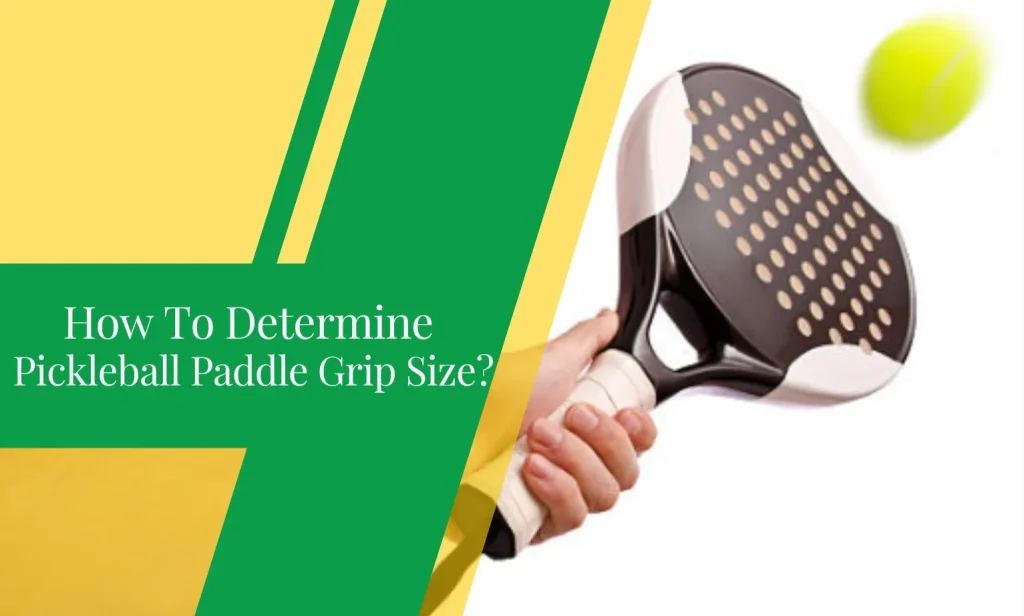Finding the right grip size is an essential step when it comes to enjoying pickleball. It’s important to consider your hand size and how it fits perfectly with smaller grips so you can have better control and achieve good spin.
If you need extra power to serve, larger grips are generally preferred for better stability and reduced strain on the elbow, shoulder, and wrist movements.
With that said, learn how to determine the most suitable pickleball paddle grip size for your play – a key factor to unlocking better performance and gaining mastery in the game!
Do Not Forget to Read: Best Pickleball Paddles

How To Determine Pickleball Paddle Grip Size?
Picking the right pickleball paddle grip size is paramount for optimal court performance. Such a seemingly small decision can make a significant difference in your play.
There are several things to consider when it comes to determining the proper grip size: handle shape, type of grip, and whether or not you want to add an overgrip.
If you decide that an overgrip is something that is necessary for you, than a half to one size lower than your normal measurement will be appropriate for your racket.
Ultimately, taking these details into consideration together—along with the design of the handle—will go a long way in helping you discover perfect Pickleball paddle grip size fit.
Do Not Forget to Read: Best Pickleball Paddles for Tennis Players
Tips When Selecting Pickleball Paddle Grip Size
When it comes to selecting a pickleball paddle, grip size is an important factor to consider. A grip that is too small or too large can impact your control and overall performance on the court.
Here are some tips to help you choose the right grip size for your pickleball paddle:
- Measure your hand: The first step in determining the right grip size is to measure the width of your hand at its widest point (usually at the base of your fingers). This measurement, known as the circumference, will help you determine the size of grip that will fit you best.
- Consider your hand size: As a general rule, players with smaller hands should opt for a smaller grip size, while players with larger hands should choose a larger grip size. A grip that is too small will feel cramped and uncomfortable, while a grip that is too large will feel loose and hard to control.
- Try out different sizes: If you’re not sure what size grip will work best for you, try out a few different sizes before you make a final decision. You can do this by using grip sizing tools or by trying out paddles with different grip sizes at your local pickleball club or pro shop.
- Think about your playing style: Your playing style can also impact the grip size you choose. For example, players who use a lot of wrist action in their strokes may prefer a smaller grip size, as it allows for greater control and flexibility. On the other hand, players who rely on power shots may prefer a larger grip size, as it provides a more solid foundation for their shots.
- Consider your comfort: Ultimately, the grip size you choose should be based on your comfort and preference. If a particular grip size feels awkward or uncomfortable, it’s probably not the right size for you.
Do Not Forget to Read: Best Pickleball Paddles for Tennis Elbow
Index Finger Test
The index finger test is a simple but effective way to determine the perfect grip size for your pickleball paddle. It is essential to have a comfortable and secure grip on your paddle in order to play at your best and prevent injuries.

To perform the index finger test, you will need a pickleball paddle and your dominant hand. Start by holding the paddle using an Eastern grip, where the index knuckle and heel pad rest on the 3rd bevel and your palm is placed on the same bevel as the string face.
Once you have a secure grip on the paddle, use the index finger of your other hand to slide it in-between your ring finger and palm.
The ideal grip size for you will be the one where your index finger fits snugly within this gap. If there is not enough room for your index finger, the grip is too small.
On the other hand, if there is a lot of space between your fingers and palm, the grip is too big.
Using a grip that is either too large or too small for a long period of time can significantly affect your game and increase the risk of injuries such as tennis elbow. Therefore, it is crucial to find a grip size that is comfortable and secure.
The Ruler Test
To perform the ruler test, you will need a ruler and your dominant playing hand. Start by opening your hand and extending your fingers as far as possible, with your fingers close together.
Next, take your ruler and align it parallel to your third finger (also known as the ring finger). Place one end of the ruler at the bottom of the second (or middle) crease in your palm.
Your paddle grip size is then determined by the length between the tip of your ring finger and the bottom lateral palm crease. The ideal length should fall between 4 inches and 5 inches. If the length falls outside of this range, you may need to adjust your grip size accordingly.
It’s important to note that the ruler test is only a guideline, and you may need to try out different grip sizes to find the one that feels most comfortable for you.
Some players may prefer a slightly larger or smaller grip size based on their hand size and playing style.
When selecting a pickleball paddle grip size, it’s important to remember that everyone’s hands are different. Some people may have larger hands, while others may have smaller hands. So, it’s important to try out a few different sizes to see which one feels the most comfortable to you.
It’s also important to consider the type of grip you prefer. Some people prefer a more cushioned grip, while others prefer a more firm grip.
There are many different types of grips available, so it’s important to try out a few different ones to see which one feels the most comfortable to you.
Finally, it’s important to consider the type of game you are playing. If you are playing a more aggressive game, you may want to consider a larger grip size to help you generate more power.
If you are playing a more finesse game, you may want to consider a smaller grip size to help you have more control over your shots.
Do Not Forget to Read: Best Pickleball Paddles for Two Handed Backhand
Pickleball Paddle Grip Size Chart
| US Sizes | European Sizes | Sizes in mm |
| 4 inches | 0 | 100-103 mm |
| 4 1/8 inches | 1 | 103-106 mm |
| 4 1/4 inches | 2 | 106-110 mm |
| 4 3/8 inches | 3 | 110-113 mm |
| 4 1/2 inches | 4 | 113-118 mm |
| 4 5/8 inches | 5 | 118-120 mm |
| 4 3/4 inches | 6 | 120-123 mm |
Why Does Grip Size Matter?
Grip size is an important factor to consider when selecting a golf club. A proper grip size can help improve your swing, reduce the risk of injury, and increase your overall performance on the course.
When a grip is too small, it can cause the hands to grip the club too tightly, leading to tension in the arms and shoulders.
This can cause a lack of control and accuracy in the swing. On the other hand, a grip that is too large can cause the hands to grip the club too loosely, leading to a lack of power and distance.
In addition to affecting your swing, grip size can also play a role in preventing injuries. If a grip is too small, it can cause strain on the hands and wrists, leading to pain and discomfort.
A grip that is too large can cause the club to twist in the hands during the swing, leading to wrist and elbow injuries.
Grip size is a personal preference and it is important to find what works best for you. It is recommended to try out different grip sizes and see how they feel in your hands before making a final decision.
Many golf clubs also offer interchangeable grip sizes, allowing you to customize the grip to your specific needs.
Do Not Forget to Read: Should You Add Lead Tape To Your Pickleball Paddle?
Are There Different Grip Sizes for Pickleball Paddles?
Pickleball paddles come in a variety of sizes, and one of the most important factors to consider is the grip size. The grip size refers to the circumference of the handle of the paddle, and it can affect your performance and comfort when playing the game.
There are three main grip sizes for pickleball paddles: small (4 – 4.125 inches), medium (4.25 inches), and large (4.5 inches). The size that is best for you will depend on your hand size, as well as your preference and playing style.
Small grip sizes are best for players with smaller hands, or those who prefer a more precise and controlled game.
The smaller grip size allows for greater dexterity and accuracy when hitting the ball, but it may not be as comfortable for those with larger hands.
Medium grip sizes are the most popular and are suitable for most players. They offer a good balance between control and comfort, making them suitable for players of all levels.
Large grip sizes are ideal for players with larger hands, or those who prefer a more powerful and aggressive playing style. The larger grip size allows for more leverage and power when hitting the ball, but it may not be as precise as the smaller sizes.
When choosing a grip size, it’s important to try out different sizes to find what feels the most comfortable and effective for you.
Some players may prefer a smaller grip size for greater control, while others may prefer a larger grip size for more power. Ultimately, the best grip size is the one that allows you to play your best game.

Michael Stevenson
Hi, my name is Michael Stevenson and I’m a passionate pickleball player. I’ve been playing the game for many years and I’m pretty highly skilled at it. Pickleball is one of my favorite topics so naturally, I love to write about it.
Whether it’s tips for beginners, guides for experts, reviews of new paddles, or advanced playing techniques – if it relates to pickleball then I have something interesting to write about it. So if you’re looking for entertaining and informative information on the topic of pickleball, look no further than my written works!